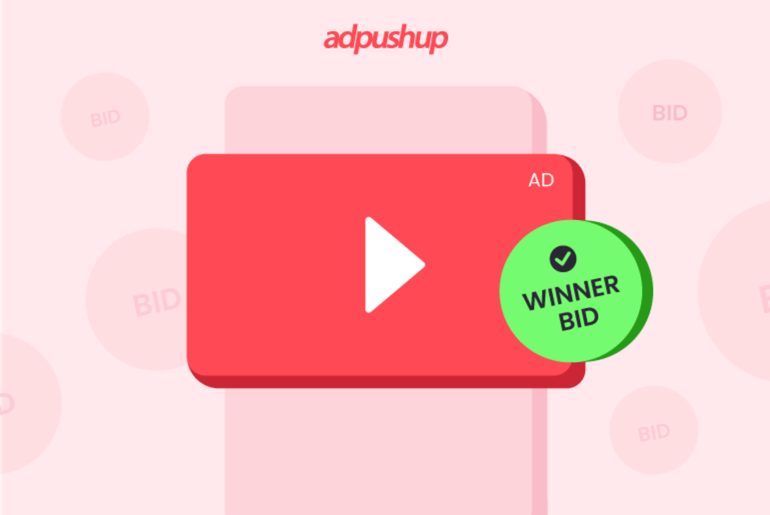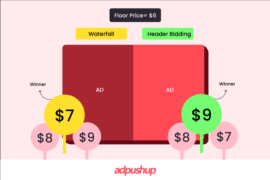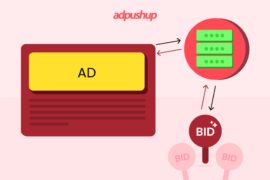In this blog, we will introduce you to video header bidding. Get into the nitty-gritty details of video header bidding, understand what it is, how it works, benefits, downsides, and much more.
Header bidding is the most efficient way of selling inventory for publishers. After its release, it has been adopted and praised by publishers and advertisers across industries. So, it won’t be strange to see video header bidding following the same path.
Due to this, vendors are experimenting and providing more options to publishers and advertisers to encourage its use. For example, OpenX, AppNexus, SpotX, and many other popular names have started optimizing their header bidding wrapper for video advertising.
Also, the fact that header bidding is now a preferred method for 75% of top publishers. The industry is seeing publishers actively implementing video header bidding for their video inventories.
More and more people are preferring video header bidding and for good reasons. According to a study, it has been found that it helps increase the ad fill rate by a whopping 57.7%. On top of that, it helps increase bid rate by 51.6%
What is Video Header Bidding?
Video header bidding is a process of making a publisher’s video ad inventory available to multiple demand sources so that their ad inventory gets the highest bid.
The process is designed as a solution to the traditional waterfall process, which was earlier used to sell video ad inventory. In waterfall, a publisher’s video ad server is required to make ad calls to demand partners one after another causing latency and reduced yield.
The concept of video header bidding is similar to header bidding in display advertising but with different execution.
The two ways to conduct video header bidding are client-side and server-side video header bidding. Just like header bidding, it involves a header bidding wrapper to conduct the auction. Video header bidding sounds a lot like header bidding in display advertising. However, the working process is quite different.
To understand how header bidding in video works, let’s first understand the technologies that are used in the video header bidding.
What are the Technologies Used in Video Header Bidding?
The complex mechanism of header bidding for video happens in just a snap. Thanks to several modern technologies and advanced algorithms, publishing websites like yours are able to display ads in seconds.
Following is the list of video header bidding solutions:
Video SSPs/Ad exchanges
Video SSP (Supply Side Platform) is no different from any other SSP. At its core, it basically helps you sell your ad inventories in exchange for some finances. However, the “video” in video SSP means that it attracts more video ad demands.
Video player
JavaScript provides its own video player to publishers. The role of a video player is to receive the ad creatives from the advertiser and display the end result to the viewer. However, in some cases, if you are unable to get an in-house JS video player, you can anytime go for third-party video player alternatives.
Video ad server
The video ad server is responsible for generating video tags. These tags can be further divided into 2 parts, VAST and VPAID. It also monitors the video ad impressions and creates video ad inventories.
Header Bidding Wrapper
The wrapper wraps the whole process by running the bidding, picking the winner, and passing the bid responses to the server.
These are major video header bidding solutions that help make the whole process as smooth as butter. We can say that the header bidding wrapper is the one finalizing the bid winner. Thus, now it is crucial to learn more about them.
Let’s take a deeper look into the role of a video header bidding wrapper.
Role of Header Bidding Wrapper?
A header bidding wrapper contains the framework needed to conduct the header bidding process. A wrapper organizes various demand partners and defines a set of rules to run the auction. Usually, a header bidding wrapper is provided by a publisher’s header bidding partner. Alternatively, it can also be accessed from open sources like Prebid.js.
Properties of header bidding wrappers are:
- It is a JavaScript tag residing in the header of a website.
- It can be used to add and/or remove demand partners from an auction.
- The wrapper can be used to set a timeout period for each header bidding partner.
- Using the wrapper, the publisher can ensure that the bid request is sent to multiple demand partners, simultaneously.
How Does Video Header Bidding Work?
As discussed, video header bidding is conducted using two methods: client-side and server-side.
Client Side Video Header Bidding
Initiation of the Process: In client-side video header bidding, a publisher puts a header bidding wrapper in the header of their website’s source code page. The procedure gets a green flag when the user visits a webpage. At this stage, the header bidding script in the webpage’s header code is triggered.
Beginning of Auction: Then, on the webpage, there is a video player to run video ads. Now, whenever an impression is available, the header bidding wrapper calls out the demand partners and conducts an auction on the user’s web browser.
Bidding Process: Interested advertisers here battle with each other to place their ads through bids. Once the bids are made, they are processed in the user’s browser.
Ad Serving: Once a winning bid is selected, the wrapper sends a signal to the ad server. The winning bid, along with the ad creative, is sent to the ad server. The ad server then delivers the winning ad to the video player on your site, displaying it to the user. During this entire process, the video player stays in the loading period.
Server-Side Video Header Bidding
Despite sharing the same objectives, both methods differ in where the bidding process occurs and how it is managed. Here’s how server-side video ad header bidding works in 5 steps:
- Initiation of the Process: At their core, both methods of video bidding follow the same principle of triggering in the web page’s header, as usual.
- Bid Requests: This is where things get a bit different. Unlike the previous method, this time the bid request is sent to an external server or technology platform.
- Processing: On the publisher’s behalf, these requests are sent by external servers to the advertisers.
- Response Handling: Advertisers now give their responses in bids and ad creatives, which are then compared, and the highest bid wins.
- Ad Serving: Finally, the bids with the highest benefits win, and are then shown to the viewer.
There’s another way advertisers pay for their ads to publishers. It’s called No Header in video ad header bidding.
No Header in Video Heading Bidding
As the name suggests, “no header” in video bidding is when the bidding process surpasses or avoids the header section of the webpage altogether.
How are the ads placed then?
Well, the auction and ad serving processes are managed entirely on the server side or through other mechanisms, without the need for a script in the webpage header.
The whole process is the same as the previous ones, except for 2 stages:
- Ads Request Initiation: Unlike client-side and server-side header bidding, there is no script in the webpage’s code. On the contrary, the video player or the ad server directly initiates the request when a visitor visits your page.
- Server-Side Bid Requests: The request is directly sent to an external server, which handles the bid request on your behalf.
Top 6 Benefits of Video Header Bidding
Video header bidding is an essential tool for publishers and advertisers to increase their revenue, improve ad quality, and enhance user experience. Here’s how we think header bidding for video ads can benefit your business.
1. Increased Revenue
The traditional programmatic advertising method, where the highest bidder in a waterfall auction gets the ad placement once the floor price (minimum acceptable bid)is met, limits revenue for publishers. They might miss out on higher bids from advertisers later in the queue.
Video header bidding solves this problem by allowing simultaneous bidding from multiple ad networks. Publishers also set floor prices, to ensure they don’t undervalue their ad space. The highest bid that meets or exceeds the floor price wins, maximizing revenue through real-time competition. Studies show this can increase CPM by up to 50%.
2. Greater Ad Quality
Video header bidding also helps to improve ad quality. With traditional programmatic advertising, the ad may take longer to load or may not be relevant to the user, resulting in a negative user experience. Header bidding for videos allow for more precise targeting, ensuring that the ad displayed is more relevant to the user.
3. User-Experience
Improving user experience is crucial to keeping visitors engaged and coming back to a website. With video header bidding, users see fewer irrelevant or repetitive ads, resulting in a more positive experience.
How? It’s simply because video header bidding reduces page latency, not to mention that the bidding is based on the user data.
4. Better Ad Fill Rate
The more publishers use header bidding in video ads, the more demand partners it will attract for publishers. Ultimately, more demand partners will help you have a better ad fill rate.
5. Promotes Transparency
Along with advertisers, you will also be able to track the performance. Thanks to bidding analytics tools, all these things are now possible for publishers too.
6. Business Resilience and Adaptability
In today’s fast-paced digital world, businesses need to be adaptable and resilient to stay ahead of the competition. Video header bidding offers this flexibility by allowing publishers to work with multiple demand sources simultaneously. This approach not only maximizes revenue opportunities but also provides a safety net in case of ad network outages or sudden changes in the market.
Also Read – How to Triple Your Video Ad Revenue: Checklist for Publishers
Are There Any Downsides of Video Header Bidding?
Increased Complexity
Video header bidding can be more complex than traditional programmatic advertising methods, requiring additional setup and technical knowledge. This may result in higher implementation costs, longer setup times, and a steeper learning curve for publishers.
Increased Page Load Times
Video header bidding requires additional scripts to be loaded on the page, which can increase page load times. This can result in slower load times for users, potentially leading to a negative user experience and increased bounce rates.
Limited Demand Sources
While header bidding in video allows publishers to work with multiple demand sources simultaneously, not all demand sources may be compatible with the technology. This can limit the number of potential buyers and result in missed revenue opportunities.
Data Privacy
There is a high chance that, even the advertisers who don’t win the bid, also get the site visitor’s cookie data. According to the EU’s General Data Protection Regulation (GDPR), cookie data is also categorized as the personal information of a user.
Lack of Transparency for Advertisers
Being a transparent option for the publisher, server-side video header bidding might not be the same for advertisers. Sadly, the advertisers are unable to find out if the publisher is biased toward any advertiser in the competition.
Technical Complexities
JavaScript provides its own video player to display ads to the website visitor. However, Flash video is the area where there might be some difficulty regarding compatibility. As a result, you might need to switch between different players as a publisher.
Best Practices for Video Header Bidding
Test & Optimize
First thing first, test and optimize your video header bidding setup regularly to ensure that you’re maximizing revenue and delivering the best user experience. Test different demand partners, floor prices, and ad formats to see what works best for your audience.
Set Realistic Floor Prices
Second, aim high with your floor prices, but at the same time, it’s also important to set realistic prices. Setting prices too high may result in fewer bids, while setting prices too low may result in leaving money on the table. Finding the right balance is key.
Use a Reliable Header Bidding Wrapper
Choosing a reliable header bidding wrapper is crucial for ensuring that your video header bidding setup is working efficiently. A good wrapper should be easy to implement, provide accurate reporting, and integrate well with your existing ad server.
Choose Your Demand Partners Carefully
Before you single out a demand partner, it is recommended to research and choose partners that have a good reputation for delivering quality ads and have a high fill rate.
Focus on User Experience
While it’s important to maximize revenue, it’s also important to prioritize the user experience. Be sure to monitor ad load times, frequency, and relevance to ensure that users are not being bombarded with too many ads or irrelevant ads.
Monitor Ad Quality
It’s important to monitor the quality of the ads being served to your users to ensure that they are not offensive or misleading. Use ad quality tools to help filter out low-quality ads and maintain a high standard of ad quality.
Some Interesting Facts About Video Header Bidding
Video ads generate better yield than display advertising. Some reports suggest video header bidding increases CPMs by 50% or more. But the profit for the publisher highly depends on experimentation (A/B testing, ad optimization and more). So, it becomes hard to say whether it is as beneficial as display header bidding or not.
Also, video ad header bidding offers a great opportunity for publishers to open up for video advertising, but it is still not the first choice for many. This is because a video impression gets accounted only when a video ad plays on a user’s device.
Moreover, there are two other concerns for publishers using video ads header bidding: page latency and technical complications.
Page load time increases in the case of a video. Since videos are considered rich media files, they take more time to render on a user’s device. Also, adding this load time to the usual time taken to run an auction for client-side bidding, cumulatively, makes the process more time-consuming.
Next is a technical complication. Most web video players support Flash rather than JavaScript code to play videos. Hence, the publishers interested in video ads are required to integrate JavaScript supported video player which is generally provided by header bidding partner/vendor.
Why All Publishers Aren’t Using Video Header Bidding?
There is another side of header bidding for video, that, not all publishers go for this option. Why so? Let’s tell you:
Scarcity of Video Inventory
Unlike regular display ads, video ad inventory is limited. Unfortunately, direct private marketplace (PMP) deals haven’t made any revolution in the industry. However, with its trends, the number of publishers using video ad header bidding is progressively rising.
Technical Challenges
As mentioned earlier as a disadvantage, many publishers refrain from it due to a bad user experience. With downsides like latency rate, higher loading time, and many others, publishers generally stay away from these to maintain the quality user experience on their web pages.
Conclusion
All a publisher wants is to maximize the yield by selling inventory. We know, both client-side and server-side header bidding has their challenges. Hence, there is no ideal method to execute the header bidding or header bidding for video ads for that matter.
However, to truly maximize the revenue, publishers need to implement and test with the video header bidding. Hence, demand for video header bidding will increase. Only if the demand increases, the industry would be interested in updating the technology and find solutions for current drawbacks.
AdPushup’s Header Bidding Solution
Merely deploying header bidding in your ad stack isn’t enough. Consistently optimizing it with technical improvements is the need of the hour. This is what AdPushup’s header bidding solution does. Through our multiple optimization features using data science and machine learning, we help publishers maximize their yield.
With our header bidding solution, you get:
- Automatic demand partner selection according to optimum requirements
- Smart timeout management
- Freedom to bring your own demand
- Bid monitoring and discrepancy resolution
Frequently Asked Questions – Video Header Bidding
To put it in a simpler way, video header bidding is a technique used by publishers, allowing them to sell their video ad space to the advertiser. The whole procedure takes place in real-time.
Video header is one of the best ways for publishers to display ads without the pop-up of any advertisement. In this method, publishers can directly upload a video file on their website instead of relying on Youtube or other video players.
Unlike traditional ad auctions, where ad space is sold to the highest bidder after a page has loaded, video header bidding allows for a more competitive and efficient process. Advertisers can bid on impressions simultaneously, allowing the highest-paying bid to win the ad space.

Deepak has a keen eye for detail and a deep understanding of the ad tech landscape. Whether it’s through in-depth articles, thought-provoking insights, or compelling storytelling, he’s dedicated to helping people navigate the complex world of ad tech with the simplicity of his words.







